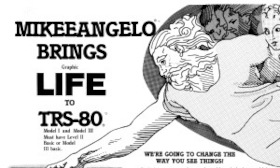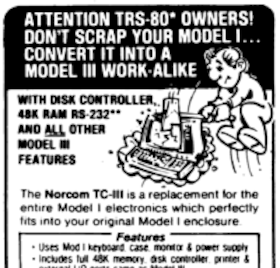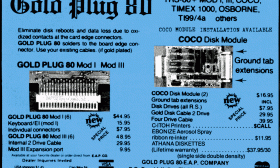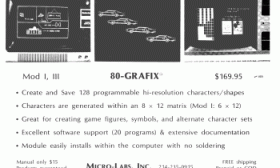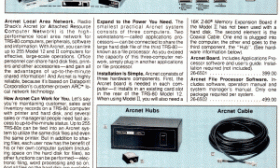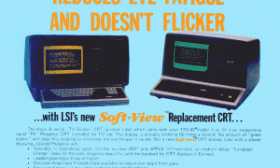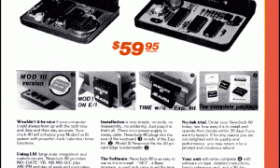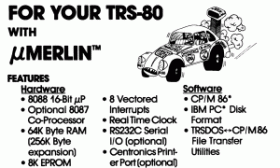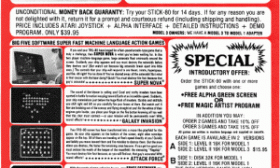Articles in the "Hardware" Category
The Mikeegraphic Graphics System was a high-resolution graphics add-on for the TRS-80 Model I and Model III. It was sold by Mikee Electronics Corporation for $340. Originally known as the Mikeeangelo when it was introduced in late 1981, the name was changed to Mikeegraphic just a few months later, presumably to avoid confusion with another product.
Unlike the 80-GRAFIX, which provided high-resolution using a programmable character generator, the Mikeegraphic used a true bitmapped graphics screen. The high-resolution screen was mapped in its entirety at the top of the TRS-80 memory.
(Read more...)
The Model III added some nice improvements to the Model I and boasted nearly complete compatibility. But there were still some areas of incompatibility. Considering that most TRS-80 software development moved to the Model III, it was understandable that some Model I owners felt left behind.
The Norcom TC-III was a $399.00 ($499.00 factory installed) motherboard replacement for the Model I that promised all Model III features right in the Model I case. It was sold by Northern Information Technology Corp. The advertisements touted the following features:
(Read more...)
There were quite a few different storage products available back in the early days of the TRS-80 Model I. In the long term, the floppy drive (and later the hard drive) completely beat out all of the competition. But back when floppy drives were considered too expensive by many, one of the most popular storage products for the TRS-80 was the Exatron Stringy Floppy.
Founded in 1974 by Robert Howell, Exatron was a supplier of automated test equipment for manufacturers and OEMs. Exatron first demonstrated the S-100 version of the Stringy Floppy at the West Coast Computer Faire in March 1978. The TRS-80 version was introduced in May 1979 at the San Francisco Computer Faire. An early price for a TRS-80 starter kit (Stringy Floppy, wafers, and software) was $299.50. The Stringy Floppy provided an additional cost savings over floppy drives because it didn’t require an Expansion Interface. By 1982, the price for a single Stringy Floppy drive had come down to $99.50.
(Read more...)
Over time, many Model I computers (particularly those with Expansion Interfaces) developed the annoying habit of spontaneously rebooting. The reason was simple: the Model I card edge connectors were solder-coated tin and had a tendency to oxidize over time. Oxidation interfered with the electrical connections and tended to cause reliability problems, particularly with the critical Expansion Interface cable.
I’m sure that anyone who used a Model I still remembers that the best to way to remove the oxidation was to use a pink rubber eraser to scrub the connectors. The usual recommendation was to clean the connectors every month but many people did it every week.
(Read more...)
Many people considered the lack of high-resolution graphics to be the biggest deficiency of the TRS-80 Model I. The maximum resolution of the Model I was 128 by 48 by using block graphics. Many games made good use of that resolution, but it was still low compared to other computers.
The 80-GRAFIX was one of several high-resolution add-ons available for the Model I. Designed by Ted Carter, it was originally sold by Programma International for $149. The 80-GRAFIX fit entirely within the Model I case and required only minimal soldering.
(Read more...)
ARCNET, which stands for Attached Resource Computer NETwork, is a networking standard that was created by Datapoint Communications in 1976. It was one of the first networking systems used by personal computers and provided a way for multiple computers to share printers and files. One of the primary advantage of ARCNET at the time was that it was substantially cheaper than its competitors, including Ethernet.
Radio Shack sold Arcnet cards and hardware for the Model II/12/16/6000 series starting in 1982. Arcnet cards were planned for the Model III and 4 but were never released. Two remnants of that planned support are the four functions labeled “Reserved for Arcnet” in the Programmer’s Guide to TRSDOS 6 and an Arcnet boot error message in the Model 4P ROM.
(Read more...)
One frequent criticism of the TRS-80 (especially the Model I) was the quality of the screen. Many complained of eyestrain and headaches after staring at the screen for a long time. Another frequent complaint was noticeable flicker, especially under poor lighting conditions.
One popular solution was the Soft-View replacement CRTs from Langley-St. Clair Instrumentation Systems, available for the Model I, Model III, Model 4, and Model 16. Their replacement CRTs used a slower-phosphor tube that was much easier on the eyes and virtually eliminated flicker. Here’s a quote from one of their advertisements:
(Read more...)
The Newclock-80 was a clock/calendar add-on for the TRS-80 released by Alpha Products in 1983. It replaced their TIMEDATE 80 clock/calendar but remained software compatible with it.
The Newclock-80 plugged into the expansion bus and required no hardware modifications. The price was $59.95 for both the Model I and Model III versions, a significant reduction from the $95 price of the TIMEDATE 80. The Model III version also worked on the Model 4. In 1985, the price of the Model I version was reduced to $39.95.
(Read more...)
The MicroMerlin (referred to in some advertisements as the µMerlin) was a MS-DOS compatible add-on for the TRS-80. It was released by Micro Projects Engineering in 1982 with a starting price of $1,195.00.
The MicroMerlin connected to the expansion bus of a computer and required no hardware modifications to the computer itself. It originally supported the Model I and Model III, but later also the Model 4 and LNW80. There were two hardware requirements:
(Read more...)
The first commercial joystick for the TRS-80, the STICK-80, was created by Alpha Products (originally Alpha Product Co.). The first advertisement I can find was in the December 1980 issue of
80 Microcomputing. The STICK-80 package included an Atari joystick and interface and originally cost $29.95.
(Read more...)
